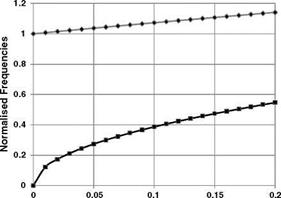Lag Frequency
The blade lag motion is under the influence of centrifugal force – not unlike blade flapping motion; however, the moment arms of these two degrees of freedom are very different (see Figure 4.26).
Since the restoring moment arm is considerably smaller for lag motion compared with flap, it is the case that the natural lag frequency is smaller than the flapping frequency for the same hinge offset from the main rotor shaft. The two frequencies (normalized on the rotor speed) are:
|
|
where e is the hinge offset normalized on the rotor radius. The variation of these frequencies with hinge offset is shown in Figure 4.27.
|
|
|
|
|
|
|

The first point to note is that the flapping frequency is always greater than unity with a zero offset giving exactly unity. This allows for a zero flapping hinge offset as seen with a teetering rotor. However, the lag frequency is below unity and equals zero for a zero hinge offset. This means that there must always be an offset for the lag hinge otherwise the rotor will not turn with the shaft. The fact that the lag frequency is less than unity opens the possibility of the helicopter suffering from a phenomenon called ground resonance. The reason for this is explained in section (4.4.6) of this chapter.












